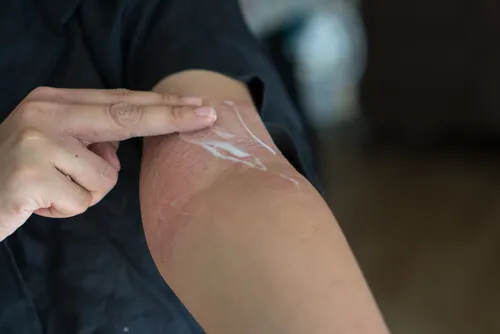Butterfly Skin: Extreme Skin Fragility


Written and verified by the doctor Leonardo Biolatto
Butterfly skin is a serious and rare disease, affecting 15 to 19 children per million live births. The medical name for the condition is ‘epidermolysis bullosa’ and it is characterized by extreme skin fragility.
It’s estimated that one in 227 people unknowingly carry the disease. Butterfly skin is a pathology of genetic origin, which is detected at birth and is incurable. It’s impossible to know if a child has it until they are born.
Butterfly skin is a painful and limiting disease, both for the sufferer and for those who care for them. It causes wounds that can affect up to 80% of the body and which cause a lot of pain. The pathology is chronic, but not contagious or infectious.
What is butterfly skin?
When we talk about butterfly skin, we’re actually referring not to one, but to a group of skin diseases of genetic origin. The main characteristic of all of them is that the skin is as fragile as butterfly wings. This causes wounds or blisters to occur with just a slight rubbing, and they can even appear spontaneously.
This disease doesn’t only affect the skin, but also the mucous membranes, and tissues in the digestive tract, eyes, mouth, and other areas. Because of this, it’s very common for affected people to have other manifestations associated with the disease, such as heart disease, esophageal narrowing, or kidney failure.
People with butterfly skin don’t only suffer injuries to their skin, but also to their internal organs. One such example are pieces of food that can cause damage to the mouth or esophagus. It’s also common for them to suffer from syndactyly (fusion of the fingers and toes).
In most cases, people with this pathology die during the second decade of life, mainly due to developing skin cancer. The more severe the case, the worse the prognosis. Currently, a stem cell treatment is being experimented with.
You may be interested in: Tips to Prevent Skin Diseases
Types of butterfly skin
There are at least 30 subtypes of epidermolysis bullosa. In all cases, the disease occurs because the skin proteins don’t function properly and this causes the skin to have no resistance to rubbing and bumps. Colloquially, this type of skin is said to lack the ‘glue’ to bind its different layers together.
The different types of butterfly skin can be grouped into three categories:
- Simplex: Wounds occur in the epidermis, which is the most superficial layer of the skin. In these cases, the blisters heal and there is no tissue loss.
- Junctional: Affects the area between the outer and inner layers of the skin. It is the rarest form and has widely varying levels of severity.
- Dystrophic: Lesions occur in the dermis, which is the deepest layer of the skin. The wounds may affect the joints and, in some cases, may limit movement.
Care and treatment

People with butterfly skin need constant care and assistance from nurses and physiotherapists. Nursing care is necessary to treat and heal the constant wounds and blisters; physiotherapy is required to delay complications that often arise over time.
Read also: Red Spots on the Skin: 25 Possible Causes and Treatments
A patient with this pathology needs to keep the skin and mucous membranes well hydrated and avoid sudden changes in temperature. Very often, they should have a soft diet, very rich in fiber and liquids. Likewise, they require special clothing and footwear which won’t cause them harm.
Treatment usually includes a psychologist and a social worker. It’s necessary to train the parents or the person in charge to take precautions and provide the care required by this condition. They also need help to be able to cope adequately with the impact of such a difficult disease.
Currently, there are several organizations in the world that are fighting for health systems to respond more adequately to the needs of these patients. In particular, the aim is to provide them with home care and support measures to increase their social integration.
All cited sources were thoroughly reviewed by our team to ensure their quality, reliability, currency, and validity. The bibliography of this article was considered reliable and of academic or scientific accuracy.
- Balleste López, I., Campo González, A., de los Reyes Degournay, R., & Sanfiel Ferrer, A. (2008). Epidermólisis bullosa: a propósito de un caso. Revista Cubana de Pediatría, 80(1), 0-0.
- Velásquez Puerta, D. A., Pineda Molina, C., Cardona Cano, M. E., Gómez Suarez, N. E., Moises, G., Grete, J., … & Londoño Peláez, C. (2008). Soluciones terapéuticas para la reconstrucción de la dermis y la epidermis. Oportunidades en el medio antioqueño. Revista Ingeniería Biomédica, 2(3), 77-83.
- Pisano, A. C. G. (2010). Epidermólisis Bullosa: piel de mariposa: tan frágil como las alas de una mariposa. Metas de enfermería, 13(5), 75-76.
This text is provided for informational purposes only and does not replace consultation with a professional. If in doubt, consult your specialist.








